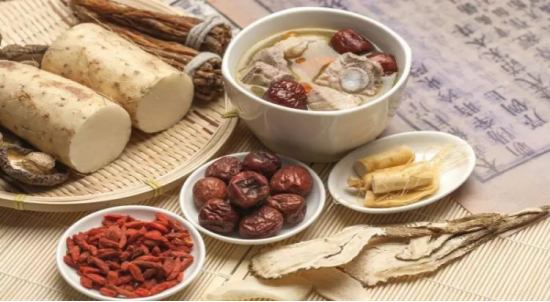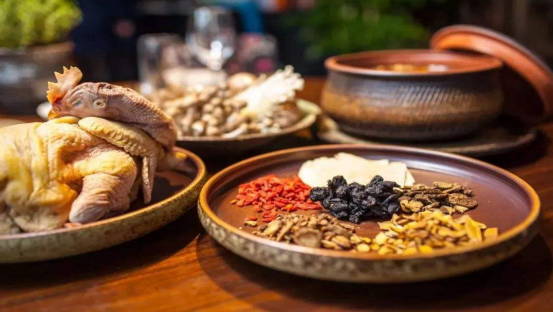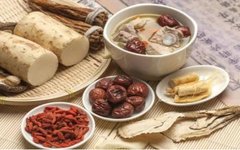Click the blue text above to follow us

Medicinal cuisine (药膳, yàoshàn) originates from China’s traditional dietary and TCM (Traditional Chinese Medicine) therapeutic culture. It is a delicious food made by strictly following medicinal cuisine recipes, combining Chinese herbs (中药, zhōngyào) with certain food items that have medicinal value, using unique Chinese cooking techniques and modern scientific methods to create dishes with appealing color, aroma, taste, and shape. In short, medicinal cuisine is a culinary art that pairs medicinal materials with food ingredients. Many people now enjoy consuming medicinal cuisine to nourish their bodies. However, in reality, many are unaware that there are many considerations to keep in mind when consuming medicinal cuisine. So, what should one pay attention to when consuming medicinal cuisine?

01What is Medicinal Cuisine?
Medicinal cuisine is an important component of TCM, a unique practical clinical discipline that has been gradually formed through thousands of years of exploration and accumulation by the Chinese nation, and is a valuable cultural heritage left by our ancestors.
The development of modern medicinal cuisine is based on summarizing ancient experiences, further improving its application to align more closely with the development of TCM theory, while also incorporating modern scientific research and applications, resulting in a more diversified development direction. Medicinal cuisine is a part of the country’s medical science. It has unique advantages in disease prevention, treatment, body nourishment, and anti-aging. For thousands of years, it has contributed to the prosperity of the Chinese nation. Chinese medicinal cuisine is not merely a simple combination of food and Chinese medicine; rather, it is a special food that is refined from herbs, food, and seasonings under the guidance of TCM dialectical dietary theory, possessing both medicinal effects and delicious flavors, used for disease prevention, treatment, and health enhancement.
02Principles of Medicinal Cuisine for Health Preservation
1. Dialectical Dietary Application is Key
Dialectical dietary application corresponds to two different methods: “same disease, different cuisine” and “different diseases, same cuisine.” The former refers to the same disease presenting different syndromes, thus requiring different dietary approaches. For example, in the case of dysentery, due to variations in onset time, region, and patient constitution, or different stages of disease development, the presenting syndromes differ. For those with damp-heat in the spleen and stomach, one should consume Ma Chi (Horse Tooth) drink and Job’s Tears porridge to clear heat and eliminate dampness; for those with cold-damp obstructing the spleen, one should consume ginger, garlic, and brown sugar soup, or patchouli and calamus porridge to warm and transform cold-damp; for those with spleen and stomach deficiency, one should consume Bai Zhu (White Atractylodes) and pig stomach porridge, or formulas to tonify the spleen and boost qi. The latter refers to different diseases presenting the same syndrome, thus requiring the same dietary approach. It is important to note that dialectical dietary application is closely related to individual, seasonal, and geographical factors. Based on a clear understanding of the syndrome, one must consider seasonal climate, geographical environment, individual constitution, age, and gender to comprehensively analyze and flexibly apply dietary methods to achieve the goal of dialectical dietary application.
2. Seasonal Dietary Matching
The “Essentials of Dietary Therapy” clearly states: “In spring, it is suitable to eat wheat to cool; in summer, it is suitable to eat legumes to cool; in autumn, it is suitable to eat sesame to moisten dryness; in winter, it is suitable to eat millet to treat cold.” From a physiological perspective, in the three months of spring, yang energy rises, and spring energy corresponds to the liver, thus medicinal cuisine should include chrysanthemum and apricot drink, rose and five-flower cake, etc., to uplift and soothe the liver; in the three months of summer, yang energy is abundant, and summer energy corresponds to the heart, thus medicinal cuisine should include bamboo leaf soup and lily porridge, etc., to clear and nourish the heart; in the three months of autumn, yang energy converges, and autumn energy corresponds to the lungs, thus medicinal cuisine should include walnut and sesame paste, mulberry and chrysanthemum honey cake, etc., to balance and moisten the lungs; in the three months of winter, yang energy hides, and winter energy corresponds to the kidneys, thus it is most suitable to tonify kidney yang, and medicinal cuisine should include deer antler wine and cordyceps stewed duck, etc. “If one can maintain this throughout life, then no diseases will arise” (from “Essential Prescriptions Worth a Thousand Gold”), all of which comply with the principles of the changes of heaven and earth through the four seasons.
3. Individual Dietary Matching
TCM medicinal cuisine has always emphasized individual differences, stressing that dietary formulations must be based on different characteristics such as constitution, age, and gender. In terms of constitution, those with yang deficiency should consume warming tonics, such as Angelica and ginger lamb soup, or deer antler porridge; those with yin deficiency should consume nourishing foods, such as tremella soup or ophiopogon porridge; those with qi deficiency should consume qi tonics, such as ginseng porridge or astragalus steamed chicken; those with blood deficiency should consume blood tonics, such as goji berry and Tianqi chicken, or chicken blood vine egg soup; those with phlegm-damp should consume foods that resolve phlegm-damp, such as tangerine peel cake or pinellia and yam porridge. In terms of age, the elderly have reduced vitality and often have deficiencies, thus they should consume easily digestible foods, such as sesame paste or peach crisp bean paste; children have delicate organs, their spleen and stomach are not yet strong, and they are prone to food injuries and parasites, thus they should consume foods that aid digestion and relieve stagnation, such as hawthorn porridge, Chinese yam porridge, or pumpkin seeds, while avoiding excessive tonics.
4. Regional Dietary Matching
Different regions have different climatic conditions and living habits, leading to variations in physiological activities and disease characteristics. As stated in “The Origins of Medicine”: “People are born with the qi of heaven and earth, thus their qi varies by region. People in the northwest have deep qi… while those in the southeast have floating and thin qi… Therefore, for the same syndrome of yang deficiency and yin excess, using methods to support yang and dispel cold, in the cold and high northwest region, one should choose strong and hot medicinal cuisine, often using ginger and attached dog meat, or deer tendon soup; while in the warm southeast region, one should choose mildly warm and weak medicinal cuisine, often using sparrow medicine porridge or goji and lamb kidney porridge. Additionally, regional differences also lead to significant variations in taste, such as sweet in the south and salty in the north, spicy in the east and sour in the west, which should be considered as much as possible when formulating medicinal cuisine.

03Precautions for Medicinal Cuisine for Health Preservation
1. When using medicinal cuisine therapy, one should pay attention to the contraindications between food and medicine, such as Huang Lian (Coptis), Gan Cao (Licorice), Wu Mei (Mume), and Jie Geng (Platycodon) should not be combined with pork; turtle meat should not be combined with mint or amaranth; chicken should not be combined with yellow eel; honey should not be combined with scallions; asparagus should not be combined with carp; Bai Zhu (White Atractylodes) should not be combined with garlic, peaches, or plums; and Ren Shen (Ginseng) should not be combined with radishes, etc.
2. For those with edema caused by hypertension, coronary heart disease, and severe heart, liver, or kidney diseases, less salt should be used in medicinal cuisine, and it should be light.
3. For individuals with obesity and atherosclerotic diseases, it is advisable to consume low-fat (especially animal fat) medicinal cuisine.
4. Diabetic patients should be cautious or avoid medicinal cuisine prepared with starchy or sugary ingredients.
5. The flavors and properties of medicinal foods should be considered, as the five flavors correspond to the five organs: pungent enters the lungs, sweet enters the spleen, bitter enters the heart, sour enters the liver, and salty enters the kidneys. Only by reasonably selecting medicinal cuisine based on flavors can one achieve the goals of nourishing the body and preventing and treating diseases.
6. Selection and processing of ingredients: The Chinese medicinal materials and food used in medicinal cuisine should be carefully selected, and necessary processing should be done to ensure the efficacy of the medicinal cuisine.
7. Cooking techniques: Excellent medicinal cuisine must emphasize cooking techniques. Medicinal cuisine should not only possess the color, aroma, taste, and shape of general food but also retain its nutritional and effective components as much as possible to better exert its therapeutic effects.
8. When decocting Chinese medicine, it is essential to pay attention to the utensils used, avoiding metal products.
9. Regardless of the purpose of medicinal cuisine, it must be consumed in moderation; excessive consumption may lead to side effects or adverse reactions.
TCM medicinal cuisine has a long history, with a wealth of literature and a complete set of simple, convenient, effective, and economical dietary methods, which are well-received by the public. However, since medicinal cuisine is composed of traditional Chinese medicine and food combinations, it is essential to follow the above application principles to fully exert its effects and achieve the goals of strengthening the body, preventing diseases, and treating illnesses.




Copywriter: Liu Heng
Reviewer: Yu Lei
Editor: Zhang Xingxing
Welcome to follow the Pharmacy Department of Inner Mongolia TCM Hospital

